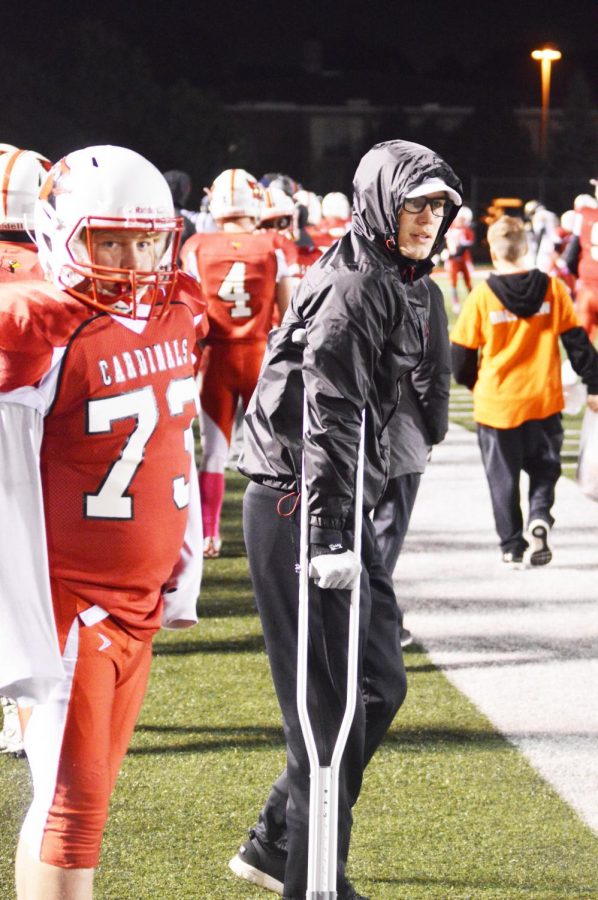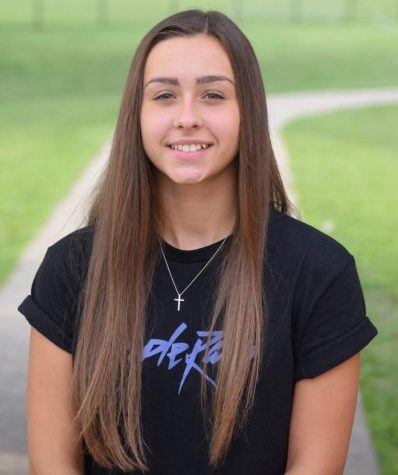Sidelined
Senior Matthew Johnston stands on the sideline while his team plays their last game in the season against Avon High School on Oct. 27, 2017.
March 16, 2018
When senior Matthew Johnston entered his first season of high school sports at SHS as a freshman, he had a specific plan in mind as to what he wanted to do with his talents after he graduated high school.
“Personally, I just wanted to go to a small D1 school,” Johnston said. “Not a school that was too big where you get overwhelmed with all of the pressure, just something small, but something that was hopefully going to be free.”
With Johnston being a three-sport-athlete, playing football, baseball and basketball and being on the varsity roster for both football and baseball, his vision seemed plausible.
This was until he began to experience a handful of severe injuries during different sports seasons throughout his high school career that shook the foundation of his future plans.
During his sophomore football season, Johnston was practicing for an upcoming game against Roncalli High School when the first injury occurred. He was running a route on the field with no defenders around when he jumped up and came down on his ankle, causing it to buckle.
“It was kind of hard to walk, but I thought it was just a sprain,” Johnston said.
Thinking the injury was just a sprain, Johnston played the rest of his sophomore football season. However, when his sophomore year of basketball came around, Johnston quickly learned that the injury was more severe than he had thought when someone landed on that same ankle.
Johnston said that he instantly knew something was wrong because it was difficult to walk. It was then that he decided to go to the doctor and have his ankle looked at, only to discover that he had broken it and needed surgery.
Johnston missed the rest of his sophomore basketball season due to the surgery, but was able to play the entire baseball season later that year.
However, he took longer to bounce back from his other injuries.
During the end of his junior football season, Johnston tore his left anterior cruciate ligament (ACL) and meniscus when he made a last second cut during a practice just two days before the sectional football game against township rival, Perry Meridian.
“My knee just kind of, exploded,” Johnston said. “It didn’t hurt or anything, but I went down and I knew it was something bad. I was just more in shock than anything.”
According to MayoClinic, a website that provides medical information and services on specific health complications, the ACL connects your thigh bone to your shin bone. MayoClinic says that the ACL is “one of the key ligaments that helps stabilize your knee joint.” Johnston also tore his meniscus, which according to the American Academy of Orthopedic Surgeons, the meniscus is defined as the “two rubbery disks that help cushion the
knee joint.”
Both tears are serious, yet common injuries among athletes. There are over 500,000 meniscus tears in the United States per year and about 150,000 ACL tears.
After being told by the doctor that he had a torn meniscus and ACL, Johnston was set to miss the rest of his junior football and baseball seasons as he underwent surgery and the recovery process soon after.
The recovery process for Johnston was a long journey. For eight weeks, he was on crutches. After three months, he could start walking. A month after, he could begin running, and finally after five months, he could start participating in agilic activities.
OrthoIndy Knee Specialist Dr. Kosmas J. Kayes says that it can take nine months or more to recover from an ACL tear. However, Johnston was back playing baseball at five months after his injury, which was questionable.
“The (bone) graft (part of a bone that’s taken and used to repair another bone via surgery) has to mature and there is a higher rate of re-tearing the graft if the athlete returns to the sport too quickly,” Kayes said in an email-interview. “Each case however, is individual.”
Johnston came back in time to finish out the rest of his junior baseball season, only playing six of 22 games. This was a huge distinction from his previous seasons of playing 19 games his freshman year and every game his sophomore year.
But after baseball, summer soon rolled around and it was time for Johnston to start football again.
Johnston said that he was having a good summer preparing for his senior football season until it all came down in a “pop” in his left knee on Aug. 15, just three days before the first game of the season. It was, again, his ACL and meniscus.
When tearing his ACL and meniscus for the first time and having to trudge through the long recovery process, Johnston says it was more motivating for him to get through that time knowing that he still had his senior year to play football and baseball. But when he injured himself the second time, it was very hard for him to come to terms with what was happening.
Johnston’s injury not only had drastic effects on himself but on his family and the people surrounding him as well.
“I was kind of lost. Right when I heard it (that he tore his ACL) I just put my head down and prayed,” Johnston said. “It took me like a month to even process that I really wasn’t going to be playing.”
According to Johnston, his mom, Teresa, was just about as lost as he was when the second knee injury happened. He believes that it affected her more than it affected him because she didn’t want to have to see him go through the mental and physical rehabilitation again.
Johnston’s mom says that when Johnston got injured the first time, she didn’t realize how serious the injury actually was, how long the recovery would be or how hard it would be on her son. However, when he was injured for the second time, knowing that her son would have to go through what he went through once again, the news hit her very hard.
“Knowing what he had gone through, and knowing how hard he had worked to get back for his senior season, when I got the news, I literally had to pull over and I was just sobbing. It was devastating…,” Teresa said. “I had seen him work so hard and do every single thing that the doctors and therapists had told him to do in order to get back, but as a freak accident, it happened again, and as a mother I was crushed for him because I know how hard he had worked.”
According to Teresa, the day Johnston received the news that he had torn his ACL and meniscus once again, he was very strong, and all he did was lower his head and tell her, “It’s going to be okay, mom.”
She says that it was in “typical Matthew fashion,” as Johnston was trying to be strong for everyone else through his struggle.
Although being in a deflating situation, Johnston tried to keep himself motivated, but says that it was a battle within himself to do so. Johnston mainly tried to stay positive by surrounding himself with positive people who were continuously trying to push him in the right direction, such as his family, friends and coaches.
Defensive back football coach Isaiah Cousins was one of the key people that helped keep Johnston motivated and positive as he dealt with his injury. According to Cousins, it was easy to keep Johnston positive throughout his injury because Johnston is a motivated type of kid, who has great faith and belief in himself.
“Going through it the first time, he was a little down on himself. I think he actually came back too fast, but again that’s just the type of kid he is. He wanted to get back out on the football field with his brothers and help them compete,” Cousins said.
Cousins says when Johnston went down and tore his ACL the second time, that it was extremely difficult for him to have to see something like that happen to someone, especially a kid like Johnston. However, Cousins continuously tried to keep Johnston positive by joking around and being there for him.
“I just tried to do what I normally do with any of the kids that I coach, and that is to make sure that I’m there for them and that they know they have someone that actually cares about them and their well being more than what they can do on the field,” Cousins said.
Johnston’s teammates and friends were also a key factor in keeping him motivated, and being there for him as he recovered.
According to Teresa, Johnston’s teammates would come over to his house and sleep on his floor next to him in the middle of the night after his surgeries in order to just be there for him and help him whenever he needed something.
When Johnston’s doctor told him that he wasn’t going to be cleared to play sports until mid-baseball season of his senior year, he decided to give up playing baseball. His goal was to primarily focus on football, in attempt of still having the chance to play collegiately.
After his first injury, Johnston was being looked at by Dartmouth College, a division one college in Hanover, N.H. However, when Johnston got hurt the second time, Dartmouth pulled away from Johnston, no longer wanting to look at him because he was “injury prone.”
Despite his injuries, Johnston was still able to achieve what he wanted to, on Jan. 19th, he committed to play football collegiately at Wabash College in Crawfordsville, Indiana.
Johnston says the experience of his injuries only made him realize and learn a lot more about himself, and the struggle overall made him a stronger person.
“You find out a lot about yourself, like what you can and can’t go through,” Johnston said. “You find out that everything happens for a reason and that there is more to sports, more to life, more to everything else, so it’s all going to work out in
the end.”



